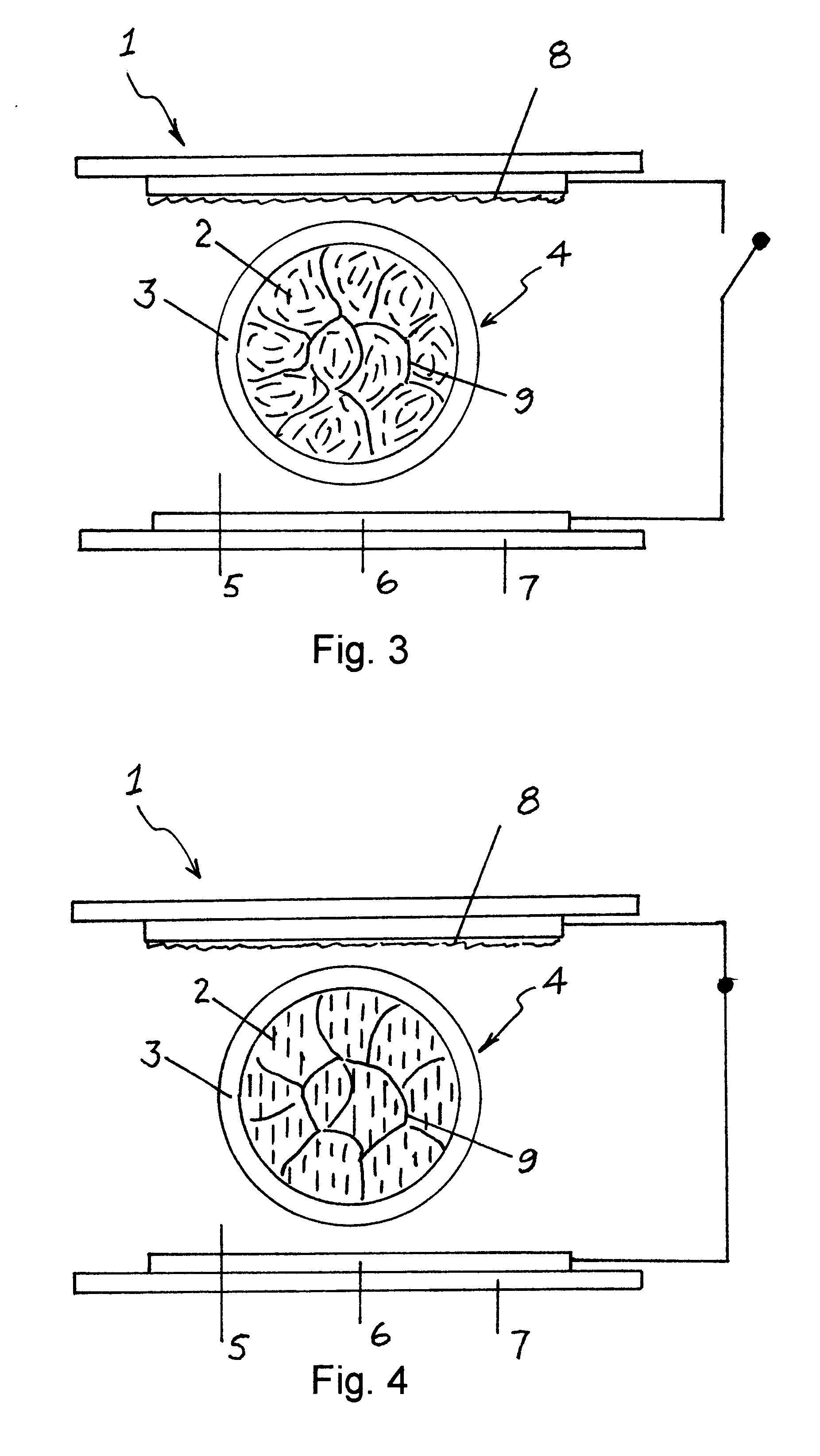Microencapsulated liquid crystal having multidomains induced by the polymer network and method
a polymer network and liquid crystal technology, applied in the field of liquid crystals, can solve the problems of dichroic based ncap film suffering problems, reducing optical efficiency, and becoming transparen
- Summary
- Abstract
- Description
- Claims
- Application Information
AI Technical Summary
Problems solved by technology
Method used
Image
Examples
example 2
A mixture of 0.06 g of M778 (a black dye mixture, available from Mitsui Toatsu Chemicals) in 4.5 g of E49 was heated with stirring for 2 hours. The resulting solution was kept at room temperature overnight. The solution was filtered through 0.2 micron PTFA membrane (available from Aldrich Chemical Co.), 0.18 g of Desmodur N-3200, 0.0035 g of benzoin methyl ether, 0.01 g of 2-hydroxyethylmethacrylate (available from Aldrich Chemical Co.), 0.01 g of pentaerythritol triacrylate and 0.09 g of PN393 were dissolved in 3 g of M778 / E49 with stirring for 15 minutes. The solution was then poured into 20 g of 10% PVA, which was undergoing stirring, and was emulsified at 50.degree. C. and 6000 rpm for 3 minutes to obtain the particle size of 1 to 5.5 microns. The stirring speed was then reduced to 2500 rpm and the reaction was continued at 50.degree. C. for 10 hours. During the reaction, 0.40 g of 10% Dabco and 0.8 g of 50% triethanolamine, 0.4 g of 10% ethylenediamine and 0.07 g of dibutyltin ...
example 3
A mixture of 0.3 g of Desmodur N-3200 and 5 g of ROTN 564 (available from Hoffman La Roche) was heated with stirring for 15 minutes. Then 0.0060 g of benzoin mehtyl ether, 0.0145 g of pentaerythritol triacrylate, 0.012 g of 2-hydroxyethyl methacrylate and 0.175 g of PN393 were added into the above solution and stirred for 15 minutes without heating. The solution was then poured into 20 g of 10% PVA, which was undergoing constant stirring, and was emulsified at 50.degree. C. and 6000 rpm for 2 minutes to obtain the particle size of 1 to 7 microns. The stirring speed was reduced to 2500 rpm and the reaction was continued at 50-55.degree. C. for 10 hours. During the reaction 0.50 g of 10% Dabco, 1.2 g of 50% triethanolamine and 0.6 g of 10% ethylenediamine were added to the solution. After the reaction was complete, 0.75 g of 10% NH.sub.4 OH was added to the solution, then the slurry was allowed to stand at room temperature overnight. The resulting slurry was purified using IEC HN-SII ...
example 4
A mixture of 2.5 g of E49, 0.15 g of PN393, 0.010 g of pentaerythritol triacrylate and 0.0048 of benzoin methyl ether was emulsified into 20 g of 5% EMA copolymer solution,(previously neutralized to pH 4.5, available from Zeeland Chemicals) at temperature of 65-75.degree. C. A 30% of Cymel 385 solution (available from Cytec Industries) was added. The stirring was continued at 6000 rpm for 5 minutes. Then the stirring speed was reduced to 2500 rpm and the reaction was continued at the same temperature for three hours. The resulting slurry was purified using a centrifuge. The liquid crystal / polymer film was prepared as a process described in Example 1, and exhibited an opaque characteristic in the off state and turned to transparent at about 15 to 20 volts and 60 Hz with 90% transmission.
PUM
| Property | Measurement | Unit |
|---|---|---|
| Electric potential / voltage | aaaaa | aaaaa |
Abstract
Description
Claims
Application Information
 Login to View More
Login to View More - R&D
- Intellectual Property
- Life Sciences
- Materials
- Tech Scout
- Unparalleled Data Quality
- Higher Quality Content
- 60% Fewer Hallucinations
Browse by: Latest US Patents, China's latest patents, Technical Efficacy Thesaurus, Application Domain, Technology Topic, Popular Technical Reports.
© 2025 PatSnap. All rights reserved.Legal|Privacy policy|Modern Slavery Act Transparency Statement|Sitemap|About US| Contact US: help@patsnap.com



